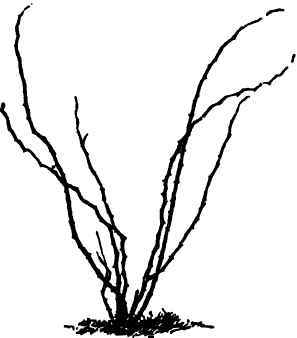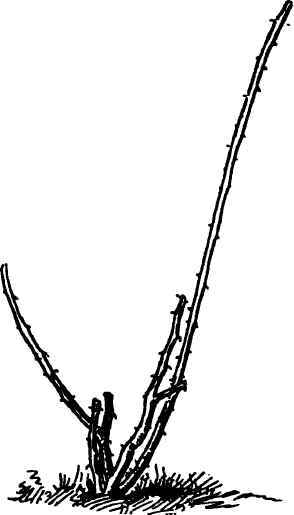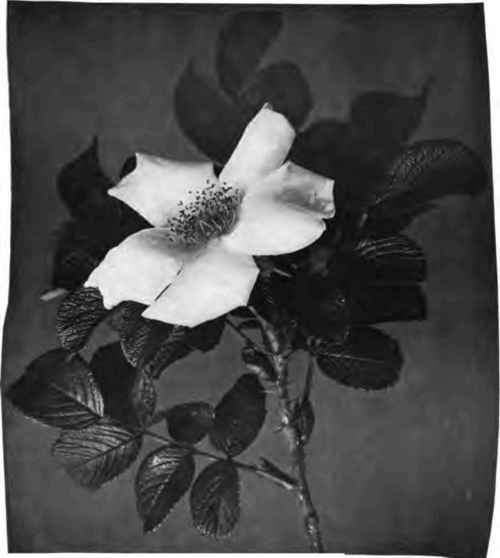V. Pruning Roses
Description
This section is from the book "How To Make A Flower Garden", by Wilhelm Miller. Also available from Amazon: The Well-Tended Perennial Garden: Planting and Pruning Techniques.
V. Pruning Roses
In Bailey's "Cyclopedia of American Horticulture" some fifty species of roses are enumerated as common in cultivation. From these species innumerable varieties have sprung. It seems impossible, in a genus so diversified, to give any general rules for pruning, but by classifying roses by their habits of growth it is hoped that some help may be given the inexperienced grower. It is assumed in what follows that the plants are well cultivated and have plenty of nourishment.
1. Hybrid Perpetuals, Hybrid Teas, Provence And Moss Roses
Hybrid Perpetuals, Hybrid Teas, Provence And Moss Roses are best grown as bushy plants. They should be severely cut back while dormant in spring, but never in summer or early autumn, as is sometimes done because they are straggling and look unkempt in an otherwise neat garden. From two-thirds to four-fifths of last year's wood, and all weak shoots, are removed. This results in strong growths, producing large flowers, the size of which can be increased by disbudding. If numerous smaller flowers are desired - i. e., quantity at the expense of quality - the shortening-in need not be carried so far. It is permissible to cut back only one-half, but this treatment is objectionable, and does not tend to keep the plants in good condition. This winter priming should be supplemented by a summer pruning, which consists of simply cutting out the flowering shoots after the flowers fade.

Hybrid perpetual rose before pruning. (General Jacqueminot).
It is already done if all the blooms have been gathered. Remove weak growths and all sprouts from the stock as they appear. As the plants age, worn-out stems must be taken out and the center left open to encourage new shoots. Some of these roses are short-lived and must eventually be replaced. Hybrid perpetual roses of weak habit - e. g., Prince Camille de Rohan - should be cut back harder than vigorous growers like General Jacqueminot, but only when in good health. Hybrid teas as a rule require the most severe pruning; moss and Provence roses least.
2. Climbing Roses
Climbing Roses - the Dawson, Baltimore Belle, Prairie Queen, Crimson Ramblers, and others - need not be pruned so hard as those above described. Cut off in spring, before the buds open, from one-fifth to one-third of the previous year's growth; also, in established plants, any of the old, flowering wood which is enfeebled. Do not hesitate, even if a part of the trellis is laid bare. It is by this means only that these plants can be kept vigorous. In summer take out most of the old wood after it is done flowering, and train new growths as desired, pinching out weak and objectionable shoots.
Half-climbing roses, like the Japanese Rosa multiflora (R. polyantha) and its varieties, the sweetbriers, R. setigera, the type and the dog rose, are commonly grown as bushes and pruned as above described, more attention being paid to cutting out worn-out stems and keeping the centers open; but the flowering wood must not be removed after blooming where fruit is desired in winter.
Trailing roses (R. Wichuraiana and its varieties) require comparatively little pruning, particularly in the North, where unfavourable seasons are apt to kill some of the wood. By taking out dead branches and cutting back enough to restore the balance opportunity is given for new growths which are essential to keep them in good condition. Half-climbing hybrids of this rose - e. g., Mr. Walsh's Sweetheart, Debutante, etc., and the old Ayrshire roses - R. arvensis (R. repens) and their varieties - are pruned in much the same way.

Crimson Rambler before pruning.

Crimson Rambler pruned (scale somewhat larger).

Rosa rugoss, one of the best roses for the shrubbery.
The Persian Yellow rose, Harrison's Yellow, and Austrian Brier are not strong growers. One must be cautious with the knife, cutting out the flowering wood after the blooms fade. In established plants the worn-out stems can be removed at any time. Scotch roses can be treated in the same way, and are much benefited by being cut clean to the ground once in about seven years. Their habit of spreading by underground stems helps the recovery.
3. Wild Roses
Wild Roses, R. blanda, Carolina, lucida, nitida, etc., are grown not only for the flowers, but for bright twigs and hips, in winter. Consequently much depends upon sturdy growth. They are frequently planted in such quantity that careful pruning is impossible. Take out the older wood from time to time, and at intervals of several years, determined by their condition, cut clean to the ground, at the same time giving manure and stirring the soil. An equally good method of renewal is to dig up and reset the plants, discarding the old and feeble.
Rosa rugosa and its variety alba do not require annual pruning, unless it be a little shortening-in of the tips - an interminable operation. After these plants are well established, however, the older canes should be cut out occasionally, thus keeping the center free and encouraging new growths. If at any time they are in bad shape from winter-killing or disease, they can be cut to the ground. Hybrids of Rosa rugosa, like Madame Bruant, are helped by spring priming, cutting back the annual growths, and thinning out old wood.
4. Tender Roses
Tender Roses, like the teas, Chinas, Bengals, and Bourbons, should be cut in at the beginning of the flowering season, and, since they are really perpetual bloomers, this process must be continued as long as the season lasts. Weak and unproductive shoots must be removed. Cloth of Gold, Lamarque, Maréchal Niel, and other roses of like habit, are closely pruned after their wood is well ripened, when they are most at rest. Under glass, this is usually done just before starting them into growth. To bloom the Cherokee rose in a cool greenhouse in January and February, four-fifths of the summer's growth must be cut away in October. Worn-out canes can be removed at any time. The double-flowered varieties of R. Banksiœ are severely cut back after the blooms have faded, in May or June, in a cool house.
Many methods are employed in propagating roses, but the practice here described is simple and effective. Cuttings can be rooted in the garden or in the greenhouse. For out-of-door work they should be made in November, before severe frost, of wood of the current year's growth. They should be cut into lengths of six inches, tied into bundles with tarred rope, and buried eighteen inches deep in sandy soil, and furthermore protected from freezing by a covering of leaves. In spring, when the ground is thawed and settled, they should be planted in V-shaped trenches in well-prepared beds, losing a little rotted barnyard manure. The cuttings should stand nearly erect, and be so deeply planted that only one bud shows above the surface of the ground, two inches apart in the row, with the rows twelve inches apart. In this way many desirable hardy roses can be multiplied - e. g., Crimson and Yellow Ramblers, the Dawson Rose, Rosa multiflora, R. Wichuraiana, and all their other progeny, R. setigera, Prairie Queen, and Baltimore Belle, etc., also the Manetti rose for stock.
Under glass, these same varieties will give a larger percentage of rooted plants if the cuttings are made two or three inches long, planted in pure sand in pots or boxes, and kept in a greenhouse, 450 F. These cuttings, also, should be made in autumn, before severe weather, of wood just completing its growth. They should be planted thickly, about one-half their length deep, and well shaded for three weeks. Keep the temperature so low that the buds will not start into growth before the cutting is rooted. The young plants can be set out in May, either directly from the cutting-bed or after having been established in pots.
Continue to:


